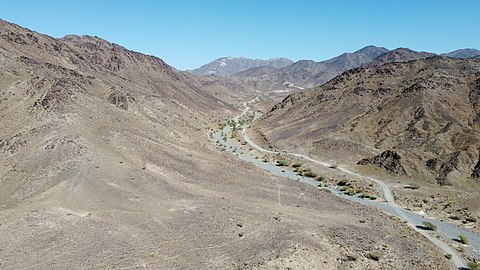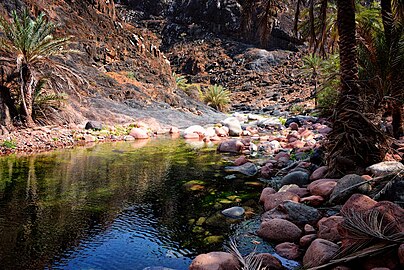Wadi
This article needs additional citations for verification. (April 2018) |

Wadi (
Arroyo (Spanish) is used in the Americas for similar landforms.[2]
Etymology
The term wādī is very widely found in Arabic
General morphology and processes
Wadis are located on gently sloping, nearly flat parts of deserts; commonly they begin on the distal portions of

Wind also causes sediment deposition. When wadi sediments are underwater or moist, wind sediments are deposited over them. Thus, wadi sediments contain both wind and water sediments.
Sediments and sedimentary structures
Wadi sediments may contain a range of material, from gravel to mud, and the sedimentary structures vary widely. Thus, wadi sediments are the most diverse of all desert environments.
Flash floods result from severe energy conditions and can result in a wide range of sedimentary structures, including ripples and common plane beds. Gravels commonly display imbrications, and mud drapes show desiccation cracks. Wind activity also generates sedimentary structures, including large-scale cross-stratification and wedge-shaped cross-sets. A typical wadi sequence consists of alternating units of wind and water sediments; each unit ranging from about 10–30 cm (4–12 in). Sediment laid by water shows complete fining upward sequence. Gravels show imbrication. Wind deposits are cross-stratified and covered with mud-cracked deposits. Some horizontal loess may also be present.
Hydrological action
Modern English usage differentiates wadis from
Wadis tend to be associated with centers of human population because sub-surface water is sometimes available in them. Nomadic and pastoral desert peoples will rely on seasonal vegetation found in wadis, even in regions as dry as the Sahara, as they travel in complex transhumance routes.
The centrality of wadis to water – and human life – in desert environments gave birth to the distinct sub-field of wadi hydrology in the 1990s.[4]
Deposits
Deposition in a wadi is rapid because of the sudden loss of stream velocity and seepage of water into the porous sediment. Wadi deposits are thus usually mixed gravels and sands. These sediments are often altered by eolian processes.[5]
Over time, wadi deposits may become "inverted wadis," where former underground water caused vegetation and sediment to fill in the eroded channel, turning previous washes into ridges running through desert regions.
Gallery
-
Arabian peninsula
-
Wadi Jib, a tributary of Wadi Shah, in the United Arab Emirates
-
The Wadi Shawkah in the United Arab Emirates.
-
Wadis in northeastern Egypt
-
A wadi in Socotra
See also
- Alluvial desert – Type of desert earth surface
- Arroyo (watercourse) – Dry watercourse with flow after rain
- Canyon – Deep chasm between cliffs
- Coulee – Type of valley or drainage zone
- Gulch – Deep V-shaped valley formed by erosion
- Gully – Landform created by running water and/or mass movement eroding sharply into soil
- Intermittent river – River that periodically ceases to flow
- Oasis – Fertile area in a desert environment
- Wād Ṭuwāin the Sinai peninsula, holy Muslim site
References
- ^ "Torrent valley". Insight on the Scriptures. Vol. 2: Jehova – Zuzim and Index. Watch Tower Bible and Tract Society of New York. 1988. p. 1115.
The term "wadi" (Arabic) is also used to designate a torrent valley ... whereas others are torrents during the rainy season but dry up completely during the rainless season.
- ^ "Arroyo Definition". MSN Encarta. Archived from the original on 6 April 2009. Retrieved 2 October 2009.
- ^ Ayuntamiento de Guadalajara, Guadalajara tourist guide, p.5. Archived 1 July 2012 at the Wayback Machine, retrieved 17 August 2013
- ^ Review of Wheater, Howard ; Al Weshah, Radwan, Hydrology of Wadi systems -IHP Regional Network on Wadi Hydrology in the Arab Region, UNESCO – Technical documents in hydrology vol 55, SC.2002/WS/33,(2002).
- .
- ^ Alimsk (20 December 2013). "Wadi Bani Khalid & Wadi Hawer". Oman Tripper. Retrieved 25 March 2018.
- ^ Pedro (5 September 2014). "Visiting Wadi Bani Khalid, Oman: A Desert Paradise". Travel With Pedro. Retrieved 25 March 2018.
Bibliography
- Summary: Drainage Courses, Wadis. United States Army Corps of Engineers. Desert Processes Working Group; Knowledge Sciences, Inc. (n.d), retrieved 2008-08-26.
- Summary: Summary: Drainage Courses, Wadis – Inverted. United States Army Corps of Engineers. Desert Processes Working Group; Knowledge Sciences, Inc. (n.d), retrieved 2008-08-2onments
- Gelennie, K. W., 1970 Deserts sedimentary Environments. Developments in Sedimentology, v.14. Elsevier, Amsterdam, 222p.

![Wadi Bani Khalid in the Northern Governorate of Ash-Sharqiyyah Region, Oman,[6][7] Arabian peninsula](http://upload.wikimedia.org/wikipedia/commons/thumb/2/20/Wadi_Bani_Khalid_East_RB.jpg/524px-Wadi_Bani_Khalid_East_RB.jpg)







